Union-State-Local Relations | Public Administration Optional for UPSC (Notes) PDF Download
Introduction
- India is a Union of States and operates as a federation. In this federal system, political power is shared between the central government (also known as the Union government) and the state or provincial governments.
- Both the Centre and the States derive their powers from the Constitution and operate independently within their respective jurisdictions.
- A key feature of this federation is the supremacy of the Constitution, which is the highest law of the land.
Division of Power vs. Separation of Powers:
- Division of power refers to the distribution of powers between the Union and the States, as outlined in the Constitution.
- Separation of powers, on the other hand, involves the distribution of powers among the three organs of the State: the legislature, the judiciary, and the executive.
- In India, the Constitution allocates the division of powers between the Centre and the States.
In this unit, we will explore the arrangement of power distribution in India, focusing on legislative, administrative, and financial aspects.
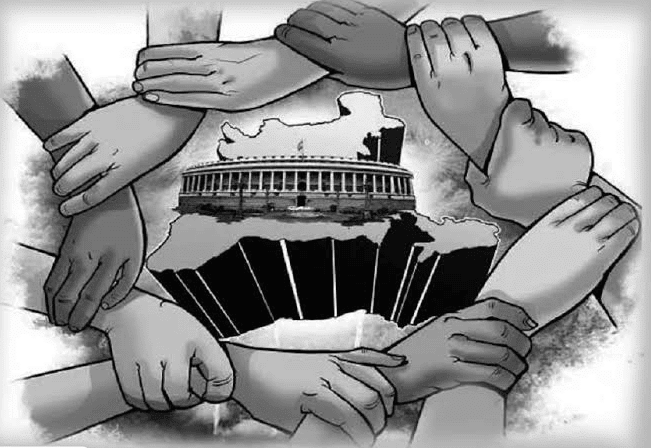
The Making of the Indian Federation
- Indian federalism has its roots in the pre-Independence era, particularly through the Government of India Act 1935, which laid down the federal structure. Subsequent efforts like the Cripps Mission (1942), the Cabinet Mission (1946), and Nehru's objectives resolution further reinforced this federal idea. However, the circumstances surrounding India's independence necessitated a robust central authority within this framework.
- Post-World War II, India grappled with economic challenges, including deficits and food shortages, compounded by communal riots during partition, which raised urgent concerns about law and order. In response, the Constituent Assembly emphasized the need for a strong central government.
- S. Nagappa, a member of the Assembly, highlighted this on November 5, 1948, stressing that a strong center was vital for consolidating the newly won freedom and ensuring national unity. The framers believed that weakening central authority could jeopardize India’s unity and integrity.
- Interestingly, the term “federation” was deliberately avoided in the Constitution. Instead, India is described as a “Union of States” in Article 1. Dr. B.R. Ambedkar clarified this choice, emphasizing that while the country is divided into states for administrative ease, it remains a single, integral entity under a unified authority.
Thus, the Constitution reflects a commitment to federal principles while prioritizing a strong central government. Scholars have debated this structure, with some viewing it as federal with a central bias, and others as more unitary. K.C. Wheare even termed it a “Quasi-federal state,” indicating a unique blend that doesn’t fit the classical definition of federalism.
Legislative Relations Between the Center and States
The Indian Constitution establishes a federal system with a clear division of powers between the Union government and State governments. Articles 245 to 255 in Part XI of the Constitution outline the legislative relations between the Center and the States. The Seventh Schedule of the Constitution contains the allocation of powers and functions between the two levels of government through three lists: the Union List, the State List, and the Concurrent List.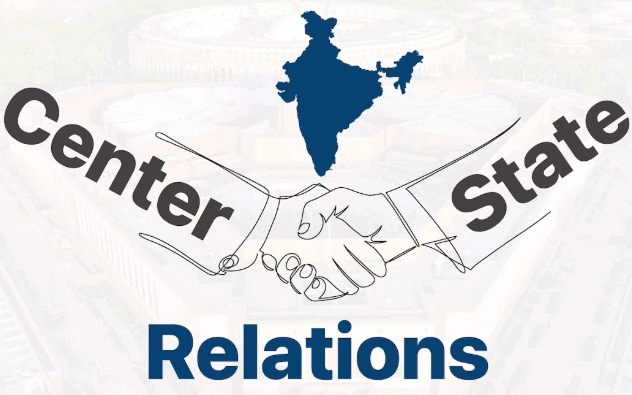
Union List:
The Union Parliament has exclusive authority to legislate on matters included in the Union List, which currently comprises 100 subjects. Important subjects in the Union List include:
- External affairs
- Defence
- Communications
- Civil aviation
- Railways
- Inter-state trade and commerce
- Banking
- Currency
- Insurance
State List:
The State Legislatures have exclusive powers to legislate on matters included in the State List, which currently has 61 subjects. Significant subjects in the State List include:
- Law and order
- Police
- Prisons
- Agriculture
- Land revenue
- Local government
- Public health
- State public services
- Fisheries
Concurrent List:
Both the Center and States can legislate on subjects included in the Concurrent List, which currently has 52 subjects. Important subjects in the Concurrent List include:
- Education
- Forests
- Electricity
- Weights and measures
- Adulteration
- Trade unions
In case of a conflict between Union Law and State Law on a subject in the Concurrent List, Union law prevails. However, if a State law on a Concurrent List subject is reserved for the President's consideration and receives Presidential assent, it takes precedence over Union law (Article 254(2)).
Residuary Powers of Legislation:
- Article 248 of the Constitution grants the Center the authority to legislate on subjects not included in any of the three lists. This includes the power to levy residuary taxes.
Center’s Control and Supremacy Over State Legislation:
In exceptional situations, the Central Government can exercise supremacy over State legislation. The Constitution empowers the Union Parliament to legislate on State List subjects in emergencies:
- Article 249: If the Rajya Sabha passes a resolution by a two-thirds majority requesting legislation on a State List subject, Parliament can legislate for a year, extendable for another year.
- Article 250: During a national emergency, Parliament can legislate on any State List subject, with laws ceasing six months after the emergency ends. State legislatures retain their power, but Parliament’s law prevails in case of disagreement.
- Article 252: If two or more State legislatures request Parliament to legislate on a State List subject, Parliament can do so.
- Article 253: Parliament can legislate for the entire country or parts of it to implement treaties, international agreements, or conventions.
- Article 356: During President’s Rule in a State, Parliament can legislate on State List subjects.
Additionally, the Center exercises control over State legislation through powers vested in the Governor and the President. The Governor can reserve certain bills passed by the State legislature for the President’s consideration. The President has the authority to assent or reject such bills. Some bills in the State List require the President’s prior permission. During a financial emergency, the President can direct States to reserve financial bills for his consideration (Article 200).
The Governor’s power to reserve bills for the President’s consideration ensures that State laws align with constitutional provisions. This discretionary power helps maintain the Constitution's integrity.
Administrative Relations Between the Center and States
- The Constitution of India established a strong central government with many unitary features. In normal circumstances, state governments exercise their constitutional powers within their jurisdiction. The executive power of the Center covers the entire India. Similarly, the State executive power extends to its territory relating to the State List subjects. However, the Union government exercise control over the States’ executive powers in several ways as specified in various provisions of the Constitution.
- According to Article 162 of India’s Constitution, the Union Government’s executive power extends to all the subjects on which Parliament can make laws. The State’s executive power shall be exercised in conformity with the laws made by the Union Parliament.
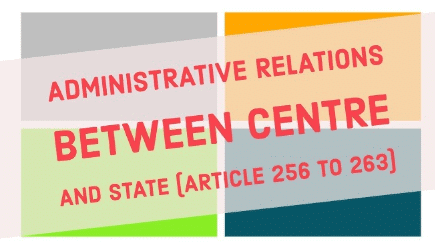
Center’s Directions to the States:
- Article 256 of the Indian Constitution entrusts that every State’s executive power is to be exercised in such a manner as to ensure compliance with the laws made by the Union Parliament. Article 257 empowers the Union Government to give necessary directions to a State for that purpose.
- The directions in this regard can be issued about communication relating to national or military significance. The Constitution also spells out the implications of non-compliance of the Centre’s directions by the States. According to Article 365, if a State fails to comply with any directions of the Union government, the President can hold that the State government is unable to carry on according to the provisions of the Constitution. Consequently, it can lead to the imposition of the President’s rule under Article 356.
Proclamation of Emergency under Article 352 and 356:
- Article 352 empowers the President of India to declare a national emergency when the security of or part of India is in danger by war, external aggression or, internal armed rebellion. During the national emergency, the Centre has the executive power to direct any state regarding the manner in which the executive power is to be exercised. The Center can proclaim the President’s Rule under Article 356 of India’s Constitution if there is a breakdown of Constitutional machinery in a State.
- During this period, the Union Government can take direct control over State machinery. The President (that means the central government) takes over any of the State Government’s functions. Almost all the states in India have been kept under the President’s rule, and this is one of the most controversial and most misused provisions of India’s Constitution.
- The irony is that Dr B.R Ambedkar, on 4th August 1949 in the Constituent Assembly, anticipates “such articles will never be called into operation and that they would remain a dead letter.” (CAD.vol.IX:111) The misuse of article 356 was started by the Nehru government and continued by successive governments irrespective of party.
- Nehru dismissed the Punjab government led by Gopichand Bhargava, despite commanding the majority in the state Legislative Assembly. The Andhra state’s government was dissolved in 1954, and in 1959 the communist government in Kerala dismissed because of political reasons.
- The Janata Party came to power in 1977 and dismissed all the state governments headed by the Congress party and dissolved the Assemblies on the strange ground that Congress Party had lost the peoples’ mandate as it lost in Lok Sabha elections. Indira Gandhi returned to power in 1980 and dismissed all Janata Party governments in the States, stating the same reason Janata Party had lost the peoples’ confidence.
Delegation of powers from Center to States:
- The President may assign specific functions to the State Government or its officers’ to which the executive power of the Union extends with some conditions or unconditionally (Article 258 of the Constitution of India).
Appointment of Governor and Role of Governor:
- The Governor is the Constitutional Head of the State in India which is a Union of states. The President of India appoints the Governor of a State. The Governor performs functions as the agent of the Center and submits period reports to the Center. Thus, the Center exercises control over States through the Governers’ office.
Governor exercises certain discretionary powers. The discretion becomes more common with reference to the following issues:
- Formation of the government after the general elections: The Governor has the discretion to decide which party or coalition is invited to form the government, especially in cases where no party has an outright majority.
- Choosing the Chief Ministerial candidate: If there is no clear mandate, the Governor must choose a Chief Minister, which may involve political considerations.
- Timing for proving majority: The Governor can set deadlines for the newly formed government to prove its majority in the Legislative Assembly.
- Assent to bills: The Governor has the power to give assent to bills passed by the state legislature or to reserve them for the President of India.
Interstate Water Resources and National Highways:
- Parliament can declare Highways and Waterways as National Highways or Waterways. Article 262 deals with waters of inter-state rivers and river valleys. Parliament can also frame the rules and regulations regarding disputes between two states or among the few states concerning water distribution.
Inter-State Council:
- Article 263 of India’s Constitution gives power to the President to appoint an Inter-State Council to inquire about the disputes that may have arisen between the States; to investigate and discuss subjects in which the Sates or the Union and States have a common interest; and, to make recommendations upon these subjects and in the particular recommendation for the better coordination and action in respect of these subjects.
All India Services:
- Both the Center and the States control the All India Services (IAS, IPS and IFS). However, the Center has ultimate control over these services, whereas States exercise immediate and relatively less control.
Center-State Financial Relation
The political independence of federal units is closely tied to their financial independence. To ensure this, the Constitution outlines how financial resources are distributed to the States. Articles 268 to 293 in Part XII of the Constitution address Centre-State financial relations. According to the Constitution, no tax can be imposed or collected without the authority of law (Article 265).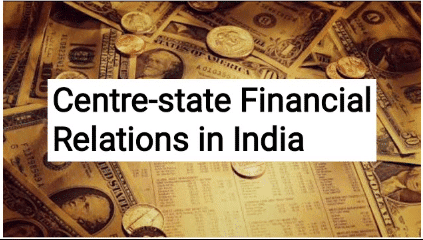
Taxation Powers:
- The Parliament has the exclusive right to impose taxes on subjects listed in the Union List.
- State legislatures have the exclusive right to levy taxes on subjects in the State List.
- Both Union and State governments can impose taxes on subjects in the Concurrent List.
- The residuary power of taxation rests solely with Parliament.
Prior to the 101stConstitution Amendment Act in 2016 and the introduction of Goods and Services Tax (GST), taxation powers were shared between the Centre and the States. The Constitution specified the mechanism for the levy and allocation of tax revenues between the Centre and the States under Articles 268, 268A, 269, 270, and 271. The 101stamendment replaced various Central and State taxes, such as excise duty, service tax, sales tax, entry tax, and entertainment tax, with a uniform GST applicable across the country.
Grant-in-Aid:
- In addition to sharing tax revenues with the States, the Centre provides Grant-in-aid to needy States from its resources. Article 275 of the Indian Constitution empowers Parliament to make such grants. Under Article 282, both the Centre and States can make grants for any public purpose, and the Centre also provides discretionary grants to States under this category for public purposes.
Finance Commission:
The Finance Commission is a constitutional body established to recommend the distribution of tax revenues between the Centre and the States. Article 280 of the Constitution empowers the President of India to appoint the Finance Commission to make recommendations on:
- Distribution of net proceeds of taxes between the Centre and the States.
- Principles governing the grant-in-aid of the revenues of the States from the Consolidated Fund of India.
NITI Aayog (National Institution for Transforming India):
- In 2014, the Union Government replaced the Planning Commission with the National Institution for Transforming India (NITI Aayog) through a Cabinet resolution. NITI Aayog aims to develop a vision for national development priorities and strategies with active involvement from the States. It promotes cooperative federalism by encouraging State participation in the economic policy-making process.
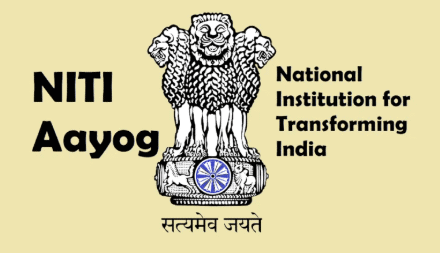
Recent Developments - The Goods and Services Tax (GST):
- The concept of Goods and Services Tax (GST) is not new. Former Prime Minister Atal Bihari Vajpayee introduced the idea of GST in 2000 and set up a committee to design GST for India. In 2003, the Government of India formed a task force on Fiscal Responsibility and Budget Management, which recommended replacing the existing tax system with a comprehensive tax on all goods and services, replacing Central and State level Value-Added Taxes (VATs).
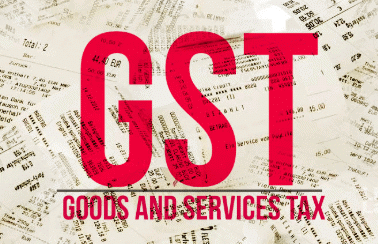
The Constitution (One Hundred and First Amendment) Act 2016:
- The Constitutional Amendment was necessary to change the tax structure and introduce GST, empowering both the Centre and the States to levy and collect GST. The 122nd Amendment Bill was introduced in the Lok Sabha in December 2014, passed in May 2015, and ratified by the required number of States. It received the President’s assent on September 8, 2016, becoming the 101st Constitution Amendment Act.
- The financial powers of the Centre and the States are distinct in the Constitution. The Centre can levy a tax on the manufacture of goods (except specific items), while the States can levy a tax on the sale of goods. In inter-state sales, the Centre levies a tax (Central Sales Tax), but the tax is collected and retained by the originating States. The Centre alone can levy Service Tax. The Centre also levies and collects tax on the sale or purchase of goods on importation and exportation from India, in addition to Basic Customs Duty.
Composition of GST Council:
The 101st Amendment inserted Article 279A, empowering the President to establish the GST Council. The GST Council was formed in September 2016 and consists of:
- Union Finance Minister (Chairperson)
- Union Minister of State in charge of Revenue or Finance (Member)
- Minister in charge of Finance or Taxation from each State Government (Members)
The GST Council recommends GST rates, exemptions, thresholds, and other matters. The Goods and Services Tax on inter-State trade or commerce supplies is levied and collected by the Union Government and apportioned between the Union and the States as per Parliament's provisions based on the GST Council's recommendations.
GST Compensation:
- The GST Council also addresses compensation for States due to revenue loss from GST implementation. The Centre compensates States for revenue loss for five years due to GST introduction. Despite losing taxation rights (except on petroleum, alcohol, and stamp duty), States faced financial strain, exacerbated by the Covid-19 pandemic, leading to delays in payments and cuts in capital expenditure.
Initially, the Centre assured full compensation to States for GST revenue losses for five years. - However, on August 30, 2020, the Union Finance Minister stated the Centre's inability to meet these dues due to the pandemic, describing it as an "Act of God." This non-payment of GST compensation became a critical issue for States, especially during the pandemic, which required substantial funding for response efforts. The estimated GST compensation requirement was around Rs 3 lakh crore, while cess collection was expected to be about Rs 65,000 crore, resulting in a compensation shortfall of Rs 2.35 lakh crore.
Attempts to Reform Center-State Relations
Sarkaria Commission:
- On June 9, 1983, the Central Government set up the Sarkaria Commission to review Center-State relations. Led by Justice R.S. Sarkaria, with members Shri B. Sivaraman and Dr. S.R. Sen, the Commission aimed to assess and recommend improvements in the functioning of these relations.
- The Commission submitted its report in January 1988, comprising 247 recommendations. It did not advocate for structural changes or a reduction in the central government’s powers but focused on operational improvements.
- One of the Commission's key recommendations was the establishment of the Inter-State Council under Article 263 of the Constitution. It also suggested that the Centre should consult States before enacting laws on subjects in the Concurrent List and recommended the minimal use of Article 356.
- In response to the Sarkaria Commission’s recommendations, the National Front Government formed the Inter-State Council in 1990, aiming to enhance cooperation and coordination between the Centre and the States.
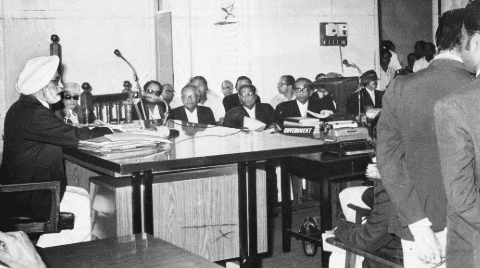
National Commission to Review the Working of the Constitution (NCRWC):
- On January 26, 2000, India celebrated 50 years of its Constitution. In this context, the National Democratic Alliance (NDA) government, led by the Bharatiya Janata Party (BJP), established the National Commission to Review the Working of the Constitution on February 22, 2000. The Commission was headed by Justice M.N. Venkatachaliah, a former Chief Justice of the Supreme Court.
- The Commission aimed to evaluate how the Constitution had functioned over the past fifty years and to suggest ways it could adapt to changing needs. Notably, Justice R.S. Sarkaria, who had previously chaired the Sarkaria Commission, was also a member of this Commission.
- On March 31, 2002, the NCRWC submitted its report, which included various recommendations regarding Center-State relations.
Madan Mohan Punchhi Commission:
- On April 27, 2007, the Government of India established a Commission on Centre-State Relations, chaired by Justice Madan Mohan Punchhi, a former Chief Justice of India. The Commission was tasked with examining and reviewing various aspects of Centre-State relations, including legislative, administrative, and financial relations, the role of Governors, emergency provisions, economic and social planning, Panchayati Raj institutions, and the sharing of resources, particularly inter-state river water.
- The Punchhi Commission conducted a thorough examination of these issues and made 273 recommendations in its report, which was presented to the Government on March 30, 2010.
|
58 videos|242 docs
|
FAQs on Union-State-Local Relations - Public Administration Optional for UPSC (Notes)
| 1. What are the key features of Centre-State Administrative Relations in India? |  |
| 2. How do State-Local Administrative Relations function in India? |  |
| 3. What are the Emergency Provisions under the Indian Constitution? |  |
| 4. How can we appraise the effectiveness of Union-State-Local Relations in India? |  |
| 5. What challenges do Centre-State and State-Local Administrative Relations face in India? |  |





















